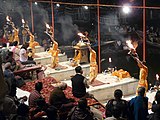Dashashwamedh Ghat

Dashashwamedh Ghat (Hindi: दशाश्वमेध घाट) is the main ghat in Varanasi on the Ganges River. It is located close to Vishwanath Temple and is probably the most spectacular ghat. Two Hindu legends are associated with it: According to one, Lord Brahma created it to welcome Lord Shiva. According to another legend, Lord Brahma sacrificed ten horses during Dasa-Ashwamedha yajna performed here.[1]
Close to the ghat, overlooking the Ganges lies the Jantar Mantar, an observatory built by Maharaja Jai Singh of Jaipur in the year 1737.[2]
Ganga aarti



A group of priests daily in the evening at this ghat perform "Agni Pooja" (Worship to Fire) wherein a dedication is made to Lord Shiva, River Ganga (the Ganges), Surya (Sun), Agni (Fire), and the whole universe. Special aartis are held on Tuesdays and on religious festivals.
Stages in the aarti ceremony
-
Preparation for incense aarti of Ganges, Varanasi Ghats.
-
Ganga aarti at Varanasi.
-
Ganga Aarti with incense at Varanasi ghats.
-
Evening Ganga aarti with incense at Ganga ghat, Varanasi.
-
Incense aarti at Dashaswamedh ghat, Varanasi.
-
Incense smoke Aarti, Ganges, Varanasi.
-
Lamps in preparation for evening Aarti
-
Multi-tiered aarti stand being lit, for Ganga Aarti.
-
Evening Ganges aarti lamp held aloft, Varanasi.
-
Aarti raised up during evening Ganga aarti, Varanasi.
-
Evening Ganga Aarti, at Dashashwamedh ghat, Varanasi.
-
Evening Aarti, at Dashashwamedh ghat
-
Aarti singers during evening Ganga aarti, at neighbouring Sitala ghat.
2010 terrorist bombing
On 7 December 2010 a low-intensity blast rocked the southern end of the aarti at the Sitla Ghat. This killed 2 people and injured 37 including 6 foreign tourists, and the Indian Mujahideen claimed responsibility for it.[3][4]
References
- ^ Dasasvamedha Ghat Varanasi official website.
- ^ Jantar Mantar Hardwick University..
- ^ "Terror strikes Varanasi: 1 killed". Zee News. December 8, 2010.
{{cite news}}: Italic or bold markup not allowed in:|publisher=(help) - ^ "Varanasi blast triggers a blame game". India Today. December 9, 2010.
External links
- Ghats of Varanasi, webpage at Varanasi official website.














